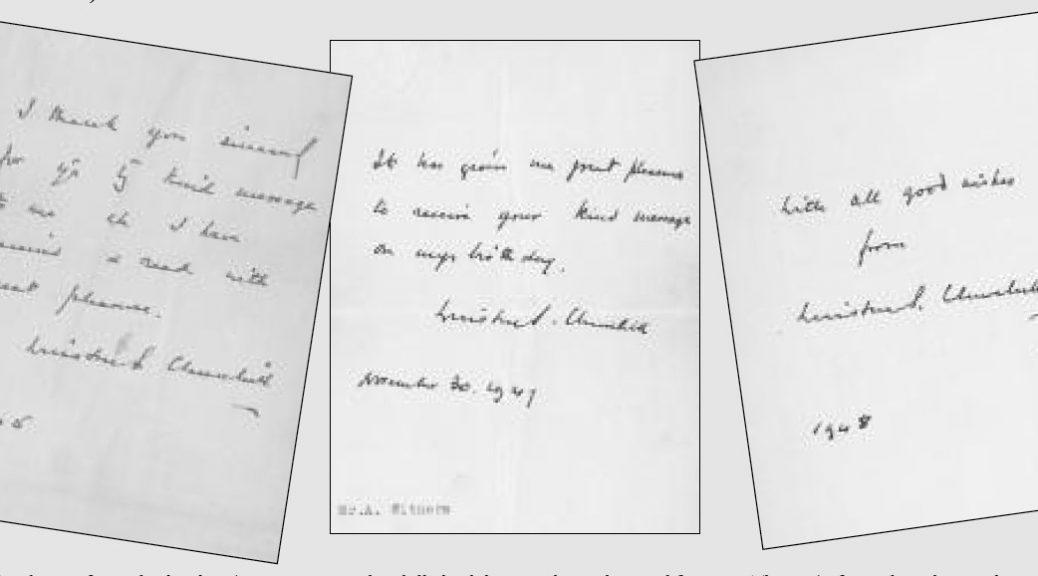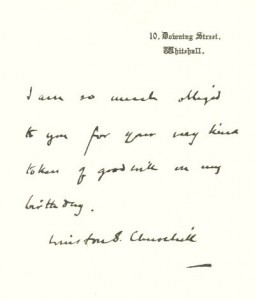
Those Infamous Facsimile Churchill Holograph Letters
Stop press 2024: originals exist!
The following article, from 2009 and updated in 2023, is republished only to alert readers that six originals of the notorious facsimile thank-you notes have now surfaced! For the details, scroll to “Addendum: the originals” below.
Don’t fall for them…
…those multiple Churchill thank-you letters, each of which is a carefully made facsimile. “The ultimate thrift shop haul,” headlined the Daily Mail. “Budget shopper is left STUNNED after buying a ‘priceless’ handwritten letter signed by Winston Churchill for just $1—after finding it buried in a New York store.”
I kept waiting for the shoe to drop on this story—but the Mail apparently believe it’s true. The letter is a facsimile, one of thousands, worth perhaps $50 if nicely framed. Apparently some are still being taken in. (Updated from 2019.)
“Signed Holograph Letter…
…by the British Prime Minister, on debossed House of Commons Notepaper, thanking a well-wisher for a kind message on his birthday, 1947. Folded once, slightly yellowed from age, otherwise a fine copy. $1200.”
This was an actual offer on the Internet, but the honest seller, alerted by an observer, conscientiously withdrew the item.
More than one collector has been taken in by these remarkable facsimile holograph notes, produced by Churchill’s Private Office from 1945 through at least 1959—some of them so convincing that casual observers swear they are originals.

Facsimile Reproductions
From 1945, at least nine variations of replica holograph notes were reproduced in quantity to thank well-wishers, whose congratulations poured in on Churchill’s birthday and other occasions. They are very well produced and appear original. They were made by a “spirit duplicator,” commonly known as a Roneo machine—similar to, but producing better quality than, a mimeograph. Early examples actually use Churchill’s blue-black ink, though they are not color separations, as I previously suspected. In any case, they are not originals and were not signed by Churchill personally.

The key to identifying a facsimile is its lack of a salutation (“My dear X”). Secretaries would simply place them in envelopes and post them by the hundreds to anyone who sent Churchill a token of respect. The value of these facsimiles on the market is incidental. A true autograph letter by Churchill is, of course, worth much more.
Origins
The first-known facsimile, dated 1945, acknowledged congratulations following V-E Day and sympathies after Churchill’s party’s defeat in the 1945 General Election. In November that year, Churchill’s birthday was the signal for well-wishers to send cards, letters and gifts. But this was not the end, or even the beginning of the end.
From the time Churchill was thrown out of office in 1945 almost until the end of his days, letters, cards and gifts flowed in. They attested to the esteem people all over the world held for him. So from time to time, his Private Office made him sit down with his big fountain pen and ink a note—sans salutation, sometimes dated, sometimes not. The original was reproduced on the Renograph and then destroyed. Run off by the thousands, they were popped into the post. Write to Sir Winston, and chances were good you would get a “handwritten” reply!
Recollection
A former bodyguard, Ronald Golding, told me: “The deluge would start in November and continue through New Year’s. It came in great sacks, delivered daily.” The boss sat down again and drafted a note for his 76th birthday in 1950. After he became Prime Minister again, the birthday greetings reached a crescendo. By then the Private Office decided not to date the thank-you note so that it could be used again the following year. The print on this and later notes is plain black ink.
For his 80th birthday in 1954, Sir Winston received many official gifts on behalf of Parliament and the Nation. This required a new facsimile note. It used light airmail paper, since many congratulations came from abroad.
After Churchill retired in 1955, the Private Office adopted Chartwell notepaper. Sir Winston’s signature was shakier by now, and 1959 may be the last time he penned one for reproduction. Sometimes the notes accompanied unsigned books.
High quality
The spirit duplicator produced convincing facsimiles, especially in the early days. The intensity of the dark blue ink varied with nib pressure, as it does normally. Churchill’s signature usually bears his characteristic flourish, and looks genuine. Of course it was—in the original prototype.
In the beginning, secretaries would often type the name and sometimes the address of the recipient at the bottom of each facsimile note. But soon the workload prevented this modest personalization. Through 1950, most notes bore an embossed House of Commons seal. When Churchill returned to office in 1951 they adopted a printed 10 Downing Street letterhead. After he retired, the heading was Chartwell, Westerham, Kent. After his hand became shaky, his private office reprinted previous notes, deleting the dates.
Values
A note to an individual, with salutation, entirely in Churchill’s own hand, is worth four figures or more, depending on the recipient. To someone like Lloyd George or Neville Chamberlain, the value would be very high; one to Franklin Roosevelt, assuming any escaped the archives, would be priceless.
But the printed facsimile notes should not command more than $50 or so on todays market. They are nice little items, fun to frame, but by no means rare.
Addendum: the originals!
I often wondered what happened to the originals penned by Churchill, long thinking they were destroyed. Not quite! We now know that at least six survive.
In September 2024 I heard from the owners of six original holograph notes Churchill wrote for reproduction. They were passed down to the granddaughter of Frank Rimell, manager of W. Straker Ltd, a printers and stationers, Ludgate Hill, London.
During the 1940s and 1950s, Strakers reproduced Churchill’s thank-you notes. At leasat six originals still exist, on embosssed House of Commons notepaper. Written between 1946 and 1950, and willed to Mr. Rimell’s heirs, they reside in the original document wallet where Frank Rimell carefully preserved them. Any reader with interest may contact me, and I will forward your message to the present owners.






